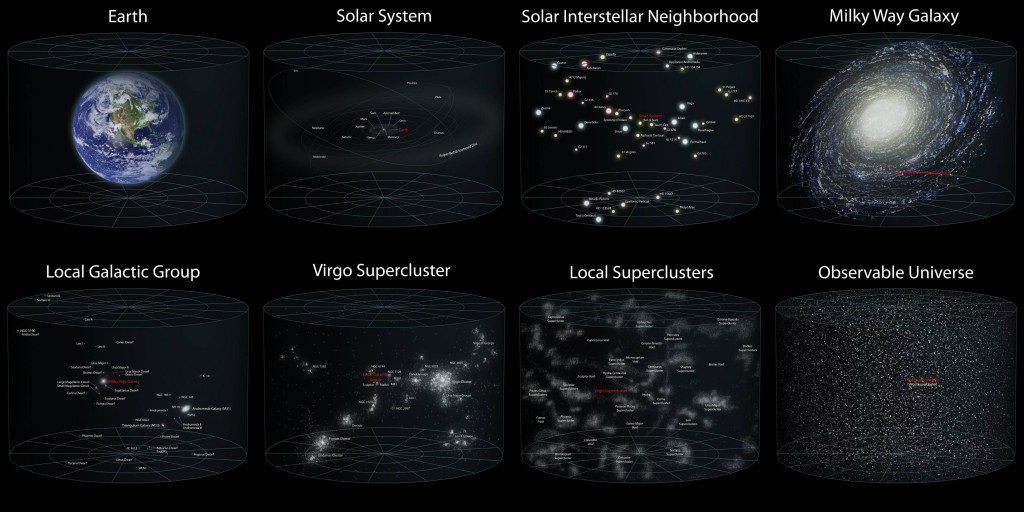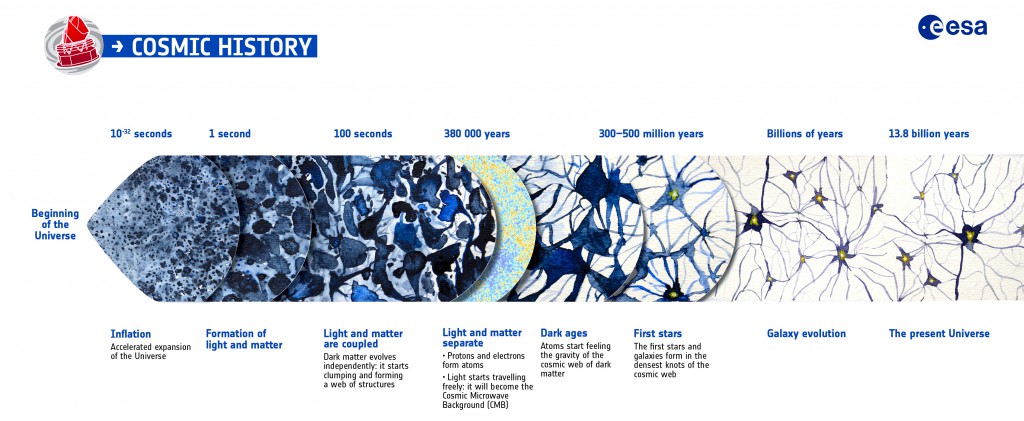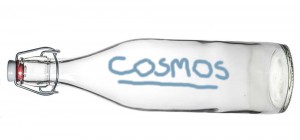Taking the Measure of Nothing in the Universe
Posted on Categories Discover Magazine

The universe bristles with structure on all scales. But really, it is all just punctuated nothingness. (Image courtesy of Cryhavoc)
Lately, I’ve been thinking a lot about nothing. Not just because focusing on nothing is a helpful, meditative antidote to obsessing over the recent barrage of anxiety-inducing news, but also because nothing is the most common thing in nature. After all, the overwhelming majority of the universe is not stars and planets; it is empty space. But empty space is not really truly completely empty. That’s what makes nothing interesting: Some places have a lot more of nothing than others, and even the emptiest places—the ones with the most nothing, you might say—still contain something. In fact, trying to figure out the nature of that something is one of the biggest unsolved issues in science.
Sorry. It does all start to sound rather mad after a while. I’ll back up and do some some explaining.
What started me down this path was a question on the site Quora: “If I went up into space, opened a jar for a few seconds, put the lid on tightly, and then came back down to my kitchen, what would be in the jar?” It’s a great thought experiment. Take a jar-size sample of different parts of the universe. What would you find inside it?
To simplify things, let’s make the “jar” a one-liter soda bottle. That’s a familiar standard size, and one that converts easily to other units. It’s 1,000 cubic centimeters, or 1/1,000th of a cubic meter, or more Pepsi than anyone should drink in one day. Now let’s start to break down the question. What’s inside a one-liter volume of “empty” space? The answer varies enormously depending on where you are. Space around low-Earth orbit is a lot different than space in some random spot between the planets, which is a lot different than the space between galaxies. To come up with a truly universal answer, I’ll do the only sensible thing and look at the universe as a whole—that is, the average density of everything we can see.
If you average out the entire cosmos, there is a total mass density of 9.9 x 10-30 grams per cubic centimeter, which is equivalent to 5.9 protons per cubic meter. Note that I was describing mass density, however, not particle density. According to the latest data from the Planck satellite, only 4.8 percent of that density consists of ordinary matter, mostly hydrogen nuclei (protons). On average, then, there is 0.3 atoms per cubic meter of space. Put in more normal terms, if you marked out a random cubic meter of empty universe, there’s a 2 out of 3 chance you would have no atoms in it. Within your one-liter bottle, you have an average of 0.0003 atoms, which is to say that there’s about a 2,999 out of 3,000 chance that your bottle is atom-free.
Then comes the dark stuff, the invisible entities that account for the other 95.2 percent of the cosmic mass density. First off, there is dark matter. We have no idea what it is. The standard theory is that it is some kind of undiscovered particle, but there are more exotic possibilities, including new kinds of fields that modify the force of gravity. According to the current interpretation, 25.8 percent of the matter density is dark…stuff. Since we know nothing about the mass of dark-matter particles (assuming they really do exist), all we can say is that, on average, you’d have about 2.6 x 10-27 grams of dark something-or-other in your bottle.
Next up, dark energy. Remember when I just told you we don’t know what dark matter is? Well, we really don’t know what dark energy is. The only thing we know is that there is some kind of energy smeared through empty space; astronomers can tell it’s there, because the energy is pushing the universe apart, causing the cosmic expansion to accelerate. Weirdly, we don’t know what it is but we have a very accurate measurement of how much of it there is: 69.4 percent of the total density of the universe. (Energy and mass are equivalent, following the equation e=mc2, and there is so much dark energy that it “outweighs” all of the matter.) That means you’d have about 6.9 x 10-27 grams of dark energy lurking in your bottle.
But wait—there’s more!
The universe is not just matter and mass. There are also particles of light and other forms of electromagnetic radiation, collectively known as photons. A lot of them, in fact. There are about 450 photons per cubic centimeter, or 450,000 of them in your bottle. I found that amazing when I crunched the numbers. Odds are, you don’t have even a single atom in your bottle, but you have nearly half a million photons. Even more amazing, most of those photons do not come from starlight. The overwhelming majority of the photons in the universe come from the cosmic microwave background—radiation left over from the Big Bang, 13.8 billion years ago. Despite their abundance, the amount of energy the microwave photons contribute is tiny. Add them all up and they are the equivalent of just 1/1,000th the mass of the atoms.
We still have one more component to go, another weird one. The universe is full of neutrinos, near-inert and near-massless particles that effortlessly penetrate ordinary matter. There’s quite a blast of them streaming from the sun; about 100 trillion of them pass through you every second. Take the big cosmic average again and there are about 330 neutrinos per cubic centimeter, or 330,000 of them in your bottle. Physicists have not yet been able to pin down the exact mass of those neutrinos. All we know for sure is that their total combined mass is very small, so small that it does not noticeably affect any of the observable properties of galaxies and the large-scale structure of the universe.
So that is the bit of universe in your one-liter jar: a bunch of photons and neutrinos that hardly add up to anything, a schmear of dark energy, an unknown smattering of dark matter, and probably no atoms at all. That’s just the average of the entire visible universe, however. What if we come closer to home?
Our crowded cosmic corner
Dark energy is (probably) the same everywhere, so there’s no need to recalculate. The density of dark matter close to Earth is very difficult to measure; I’ll ignore it here, too. But the matter density increases like crazy when you get closer to home. The space between the planets is filled with the solar wind, a steady flow of particles (mostly more protons—the universe really likes protons). At Earth’s distance from the sun, the density of the solar wind is 9 protons per cubic centimeter, or 9,000 of them in your 1-liter bottle. Even ignoring interplanetary dust, the “empty” space around Earth’s orbit has 25 million times the matter density of the average universe.
Come to low-Earth orbit and things get a whole lot more crowded. At an altitude of 400 kilometers (about 240 miles), where the International Space Station orbits, there is still a lot of wispy atmosphere blowing around. The matter density there varies quite a bit, but it is on the order of 10 quadrillion times the cosmic average. When you see photos of astronauts doing a spacewalk in orbit, it sure looks like they are floating around in a vacuum. By cosmic standards, though, they are plowing through a veritable fusillade of atmospheric atoms. The non-vacuum up there is dense enough, in fact, that atmospheric drag keeps pulling the station down, requiring regular orbital boosts. It’s all relative.
Return to sea level where you are now, more or less, and you need to recalibrate significantly again. The density of Earth’s atmosphere at the ground is about 0.0012 grams per cubic centimeter. That is a factor of a trillion higher than what it is in low-Earth orbit. More to the point, it is 2 x 1027 times the average matter density of the universe. You could call that two octillion, or you could write it out: You are breathing a bit of universe that has been concentrated by a factor of 2,000,000,000,000,000,000,000,000,000. Your body is another factor of 1,000 denser still.
The extreme dynamic range of density is what gives the universe order. The exceedingly low density out there, between the galaxies, is what makes space transparent, allowing us to see nearly all the way to the outer limits of cosmic expansion. The staggeringly high density down here is what concentrates enough matter and energy to make life possible. And the organizing factor that gave rise to those the vastly varying structures is simplicity itself. It is just the pull of gravity, slowly but relentlessly amplifying little lumps and clumps. Give gravity enough time and those clumps turn into planets, atmospheres, and eventually people.
Follow me on Twitter for the latest science news and discoveries: @coreyspowell

The history of the universe is fundamentally about gravity creating dense patches of matter surrounded by enormous rarefied voids. (Credit: ESA)
